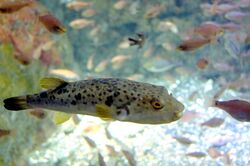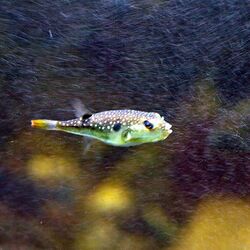Biology:Grass puffer
| Grass puffer | |
|---|---|

| |

| |
| Scientific classification | |
| Domain: | Eukaryota |
| Kingdom: | Animalia |
| Phylum: | Chordata |
| Class: | Actinopterygii |
| Order: | Tetraodontiformes |
| Family: | Tetraodontidae |
| Genus: | Takifugu |
| Species: | T. niphobles
|
| Binomial name | |
| Takifugu niphobles (D. S. Jordan & Snyder, 1901)
| |
The grass puffer (Takifugu niphobles), or Kusa-fugu (Japanese: 草河豚), is a species of fish in the pufferfish family (Tetraodontidae). This common to abundant species is found in the northwest Pacific Ocean in China (including Hong Kong and Taiwan), Japan , Korea, the Philippines and Vietnam.[1] It is primarily found in coastal waters, ranging to depths of 20 m (66 ft), but is often seen in brackish water and has also been recorded briefly entering freshwater.[1] The grass puffer reaches up to 15 cm (6 in) in length.[2]
Breeding
The grass puffer has a highly unusual breeding behavior where large groups gather seasonally in shallow water along certain beaches during high tide, throw themselves onto land (with the help of an incoming wave) where fertilization occurs, and then return to the water.[3][4] The fertilized eggs may be swept back to the sea or stay on land under rocks for a period,[1] but in the latter case they only hatch when submerged by water during a later high tide.[5] Such a breeding behavior is not known from any other pufferfish, but is known from the unrelated capelin and grunion.[6]
Relationship with humans
The grass puffer is often caught off beaches, docks, and piers using various baits such as worms, shrimp, sea lice, or cut fish. They are popular for children to catch and even popular as pets, but their intestines contain the extremely potent pufferfish poison tetrodotoxin which is potentially lethal to humans.[1][2] The species is not specifically targeted, but sometimes taken as part of the fugu fishery.[1]
See also
References
- ↑ Jump up to: 1.0 1.1 1.2 1.3 1.4 1.5 Shao, K.; Liu, M.; Hardy, G.; Leis, J.L.; Matsuura, K.; Jing, L. (2014). "Takifugu niphobles". IUCN Red List of Threatened Species 2014: e.T21341A2775256. doi:10.2305/IUCN.UK.2014-3.RLTS.T21341A2775256.en. https://www.iucnredlist.org/species/21341/2775256. Retrieved 12 November 2021.
- ↑ Jump up to: 2.0 2.1 Froese, Rainer and Pauly, Daniel, eds. (2017). "Takifugu niphobles" in FishBase. March 2017 version.
- ↑ Motohashi E., Yoshihara T., Doi H., Ando H. (2010). "Aggregating Behavior of the Grass Puffer, Takifugu niphobles, Observed in Aquarium During the Spawning Period". Zoological Science 27 (7): 559–564. doi:10.2108/zsj.27.559. PMID 20608844.
- ↑ Yamahira K (1997). "Proximate factors influencing spawning site specificity of the puffer fish Takifugu niphobles". Marine Ecology Progress Series 147: 11–19. doi:10.3354/meps147011. Bibcode: 1997MEPS..147...11Y.
- ↑ Martin, K.L.; A.L. Carter (2013). "Brave New Propagules: Terrestrial Embryos in Anamniotic Eggs". Integrative and Comparative Biology 53 (2): 233–247. doi:10.1093/icb/ict018. PMID 23604618.
- ↑ Martin, K.L.M. (2014). Beach-Spawning Fishes: Reproduction in an Endangered Ecosystem. CRC Press. ISBN:978-1482207972.
Wikidata ☰ Q2418053 entry
 |


